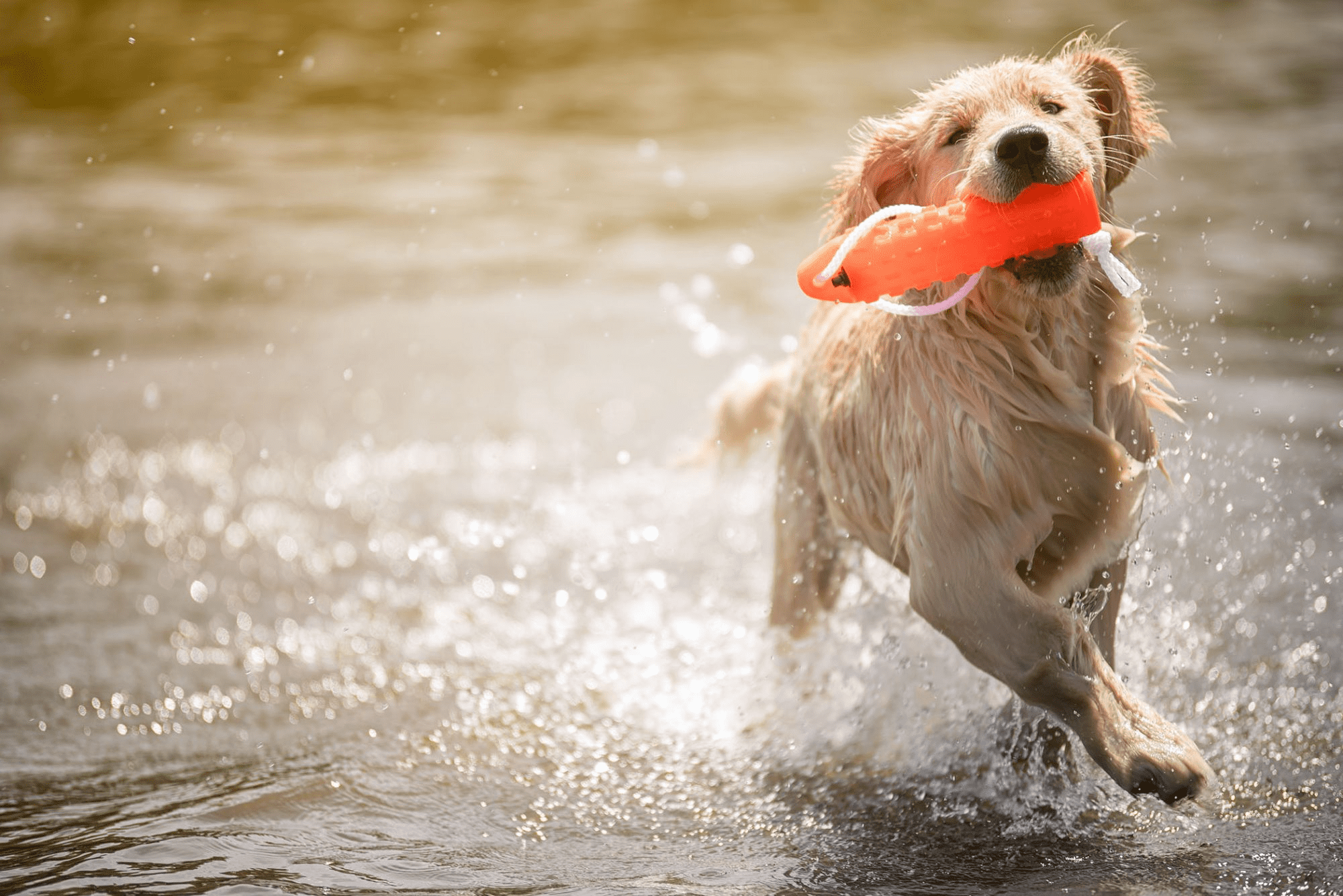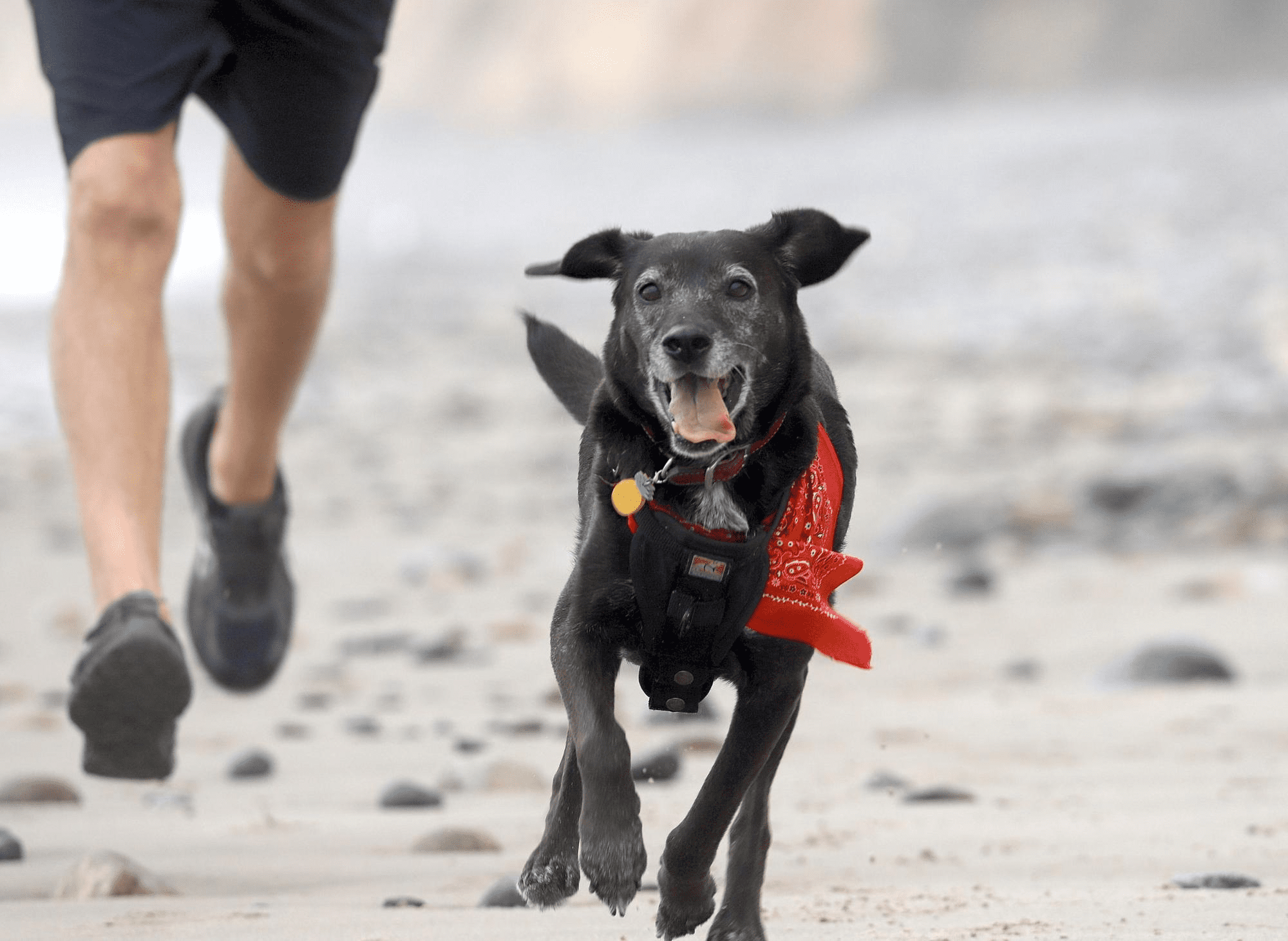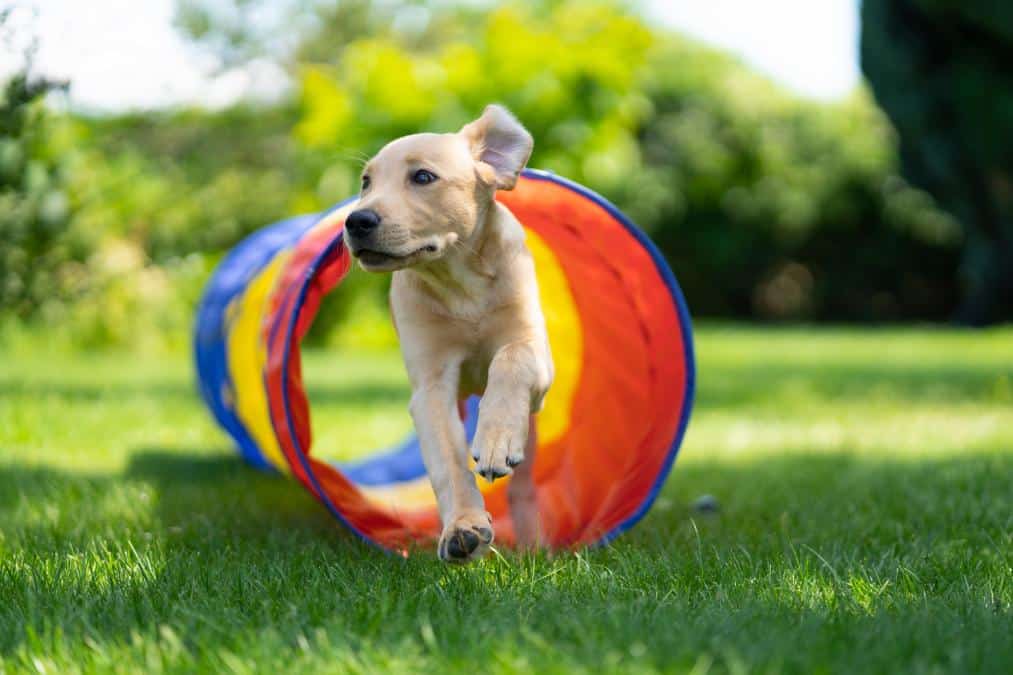Responsible dog owners will do all they can for their pet’s well-being. In the case of Labradors, maintenance is relatively easy, but they are very high-energy dogs that need plenty of regular exercises.
Some of the best things a Labrador can do for exercise are going for walks and runs, hiking, and playing with a frisbee. You can also consider scent work, indoor games, and dog sports.
In this article, I will detail the best things your labrador can do for exercise. Keep reading to make sure your labrador retriever stays strong and healthy throughout their life.
1. Walks or Runs
Your Labrador will enjoy what you like doing, so there is no need to complicate exercise if you can keep it easy.
Dogs enjoy running and walking, especially if you do it with them. They can also benefit from bikejoring, where you attach an elastic line to your dog while you bike or run.
To diversify your walks, you can choose to alternate flat and hilly terrains.
Remember to give your Labrador some time to follow its nose and explore various paths that diverge from your usual route. Allow interactions with other dogs during walks whenever possible and appropriate.
Allotting a daily twenty to thirty minutes of walking allows your Labrador to hit the American Heart Association’s recommendations for a dog’s physical activity.
If you want to take it a notch higher for a bit more excitement than your classic run or walk, there are less traditional dog exercises, like bringing your Labrador to yoga or doing a floor workout with your dog.
After your joint session, reward your Labrador with a cool-down walk, hugs, and treats.
2. Core Strength Exercises
A research survey showed that these core strength exercises help prevent ligament injuries. Any movement can work to minimize risk, but balance exercises are ideal.
Some of the best core strengthening exercises you can do with your dog are scent work, dock diving, and barn hunting.
3. Indoor Games
Who says that you should always provide exercise opportunities for your Labrador outdoors? There are creative indoor games out there that can engage your Labrador physically and mentally.
A good example is playing hide-and-seek with your dog using their favorite treats and toys. Your Labradors might also want to chase laser pointers.
Providing an opportunity for play and indoor exercise will also give your Labrador variety. These enrichment activities are similar to what zookeepers do to help animals acclimate to their environment and not get bored with the same routines.
On top of this, a dog’s mental exercise matters. You can give your Labrador some good old mental stimulation by asking it to search for hidden items inside the house or complete particular tasks.

4. Dog Camps
If you want to give your Labrador a fun experience, you can check out day camps and dog parks. Many communities have canine daycare facilities.
These camps also have indoor playgrounds and lots of opportunities for your Labrador to commune with other dogs. Some centers even come with indoor agility courses.
Consider this if you anticipate being unable to be with your Labrador for enough exercise. You’ll need to pay for a few hours of supervised training. Check whether the facility can handle your Labrador’s size.
5. Flyball and Frisbee
As a form of dog exercise, flyball is practical and very demanding. It’s also a good idea for high-energy or anxious dogs.
If you believe your Labrador might be good for a competition sport, flyball works as suitable training.
Throwing a frisbee will also let your dog exercise by jumping and grabbing the disc in the air. You can try this if you also want to be more involved in your dog’s exercise. While you teach your dog to catch the disc, you’ll also learn how to throw a frisbee.
6. Training Tricks
If you and your dog are up for it, having them engage in training tricks, whether simple or complicated, is a good form of exercise for your Labrador. They get to keep their minds active and their bodies engaged while also learning the value of focus.
There are many tricks you can check out. You can easily find videos on training tricks such as jumping through your arms or carrying baskets.
Recommended Read: Best Labrador Training products/Courses.
7. Obedience Classes
If you have the budget, enroll your Labrador in obedience training classes. There are primary and advanced options that training centers offer.
Trainers will handle your Labrador in these centers and determine if they’re a good candidate for group classes. If your Labrador is a good fit, that is a good starting point for interactive exercise experiences with other dogs.
Additionally, the positive reinforcements that trainers hand to dogs in obedience classes make for a good and fun experience for your dog. You can also opt for in-home training if you have the space and resources.
8. Puzzle Toys
You can do a lot with puzzle toys for your Labrador exercise regimen. Using puzzle toys allows you to combine mental and physical stimulation for your dog.
Studies show that puzzle toys reduce barking behaviors and increase exercise time, underscoring that dogs also learn the value of praise through it.
You can also pick puzzle toys with hidden compartments and fill those with treats. Make your Labrador exercise by sliding, tipping it over, or lifting pieces to have the hidden food as a reward.
Another puzzle toy to consider is the snuffle mat, which will utilize your dog’s sense of smell. Hide food in the mat’s grass-like strands, and your dog’s hunting instincts will be on the go; exploring the toy and finding the food provides an exhilarating mental and physical challenge.
A good idea to maximize puzzle toys is to combine feeding time with it. Rather than just placing food on a dish, your puzzle toy can have a tasty treat on the other end. There are many possibilities for your dog to get its reward.
Remember to pick non-toxic, safe, and durable toys. A dog’s exercise can be strenuous, so your toys must be able to endure excessive wear and tear.
Take great care not to feed your Labrador with too many treats, as you risk overfeeding them.
How Much Exercise Does Labrador Need?
Labradors need around 60 minutes of regular exercise. This can vary depending on how active your dog is. Labrador puppies don’t need dedicated exercise, as their usual playtime provides enough activity.
Some Labradors are more high-energy than others and can go at it for as long as 90 minutes, while others may get tired with only 45 minutes.
You can slowly start giving structured exercise to your Labrador after they reach 3 months of age. Start with only a few minutes and increase it bit by bit until they reach 18 months.
Once they’re 18 months old, you can start training your Labrador for high-intensity activities such as hiking. If your dog isn’t used to doing anything much more intense than walking, then go slowly. You don’t want to over-exert your dog.
As your Labrador enters their senior years, they won’t be able to take on as much exercise as they did before. You may want to dial down your regular exercise, such as going for walks instead of jogs. However, you shouldn’t completely eliminate exercise unless your vet says so.
Exercise Tips for Labrador Retriever Owners
Exercising your dog increases their bone health and lung and organ function. It also promotes good muscle tone and prevents bone illnesses, brain disorders, and other injuries, including behavioral and emotional quirks.
On top of the many things a Labrador can do for exercise, other considerations should be taken to ensure that your Labrador is in top shape.

Exercise With Your Dog
Many of us lead busy lives, and it can be hard to find time to exercise ourselves and our dogs. Luckily, there’s a solution for this: you can do both things at the same time.
There are many ways to exercise with your dog on top of the usual movement involved in walks and throwing a ball.
As mentioned earlier, you can go for a run with your dog as long as you have the appropriate leash. You can also go for a hike with them, which might be demanding enough for both of you. However, Labradors are smart and will happily take on more structured games and activities.
Perhaps the most well-known dog sport is canine agility. In this sport, dogs run through an obstacle course where they have to make jumps, get through tunnels, and traverse walkways. This requires a lot of cooperation from their owner, who will have to run along with them.
The options are endless. If your dog likes water, you could go for a swim with them. You can also do sprinting challenges with your Labrador.
If you want something more unusual, you could sign up for Doga, which incorporates your pup into a Yoga practice. There are even freestyle dancing classes where you can bring your dog!
Prepare Proper Footwear
Many dogs suffer from burns on their paw pads from walking on hot pavements. There’s also a risk of heat stroke. If you´re exercising your Labrador on a very hot surface, they need protective footwear.
Dog footwear often comes in the form of slip-on silicon booties. You can purchase them from various pet retailers.
It’s also a good idea to do a quick pavement check. The rule of thumb is that if your hand cannot stand a pavement’s heat for three to five seconds, you should not let your dog walk on it.
Give Your Dog Enough Water
Like humans, dogs need water breaks when they exercise. Make sure they always have access to water and be aware of the temperature and humidity. You may want to avoid extreme temperatures in the summer by limiting exercise times to early morning or late evening.
Prevent Heat Strokes
Those new to taking care of dogs might be unaware of a dog’s risks of heat strokes. Labradors are prone to this condition, as the chances are higher for long-coated and dark-haired breeds like them.
That is why you need to consider the temperature during your Labrador exercise. When it’s hot, making a splash with backyard sprinklers and kiddie pools can still give the Labrador the exercise they need.
If you’re not confident in your dog’s swimming skills, life vests are available in pet retailers. You also want to ensure that your Labrador finds their way to climb in and out of the pool.
Introduce Structured Activities
While any form of movement will do your Labrador good, having a structured activity is still the best option.
Structured activities can also help address any existing behavioral problems of your Labrador, such as barking or chewing. You’re giving them time to spend with you and an outlet for energy is a good way for the dog to exercise.
Here are some options for structured activities for your Labrador’s exercise time:
Have your dog play in a dog park.
Make leashed walks a habit.
Give off-leash time in a safe space to allow “dog speed” play.
Provide a sandbox.
Hang an inner tube or rope from a tree branch so that your Labrador can play tug.
During fall, play a game of fetch by raking some leaves and allowing your Labrador to chase a ball through the piles.
Try Natural Dog Supplements
Just like us, our furry friends can benefit from a little extra nutritional support. Supplements can be a great way to address specific health concerns, fill nutritional gaps in their diet, or simply give them an extra boost of vitality.
To explore the different types of supplements available and discover which ones might be the perfect fit for your Lab, check out our comprehensive guide on supplements for Labrador Retrievers.
Recommended Read: 3 best Supplements For Labrador Retrievers
Talk to Your Vet
A vet can inform you about the unique exercise needs and limitations of your dog. Some health issues, such as cardiac conditions, might limit the amount or type of exercise they can engage in.
On the other hand, if you want to get involved in dog sports or other demanding activities, you might want to ask your vet for things such as nutritional requirements.
You can consult your vet regarding specific activities, time limitations, proper intensity levels, and whether your dog needs group activities. Have provisions for your Labrador to access resources like water, shade, and shelter while exercising.



